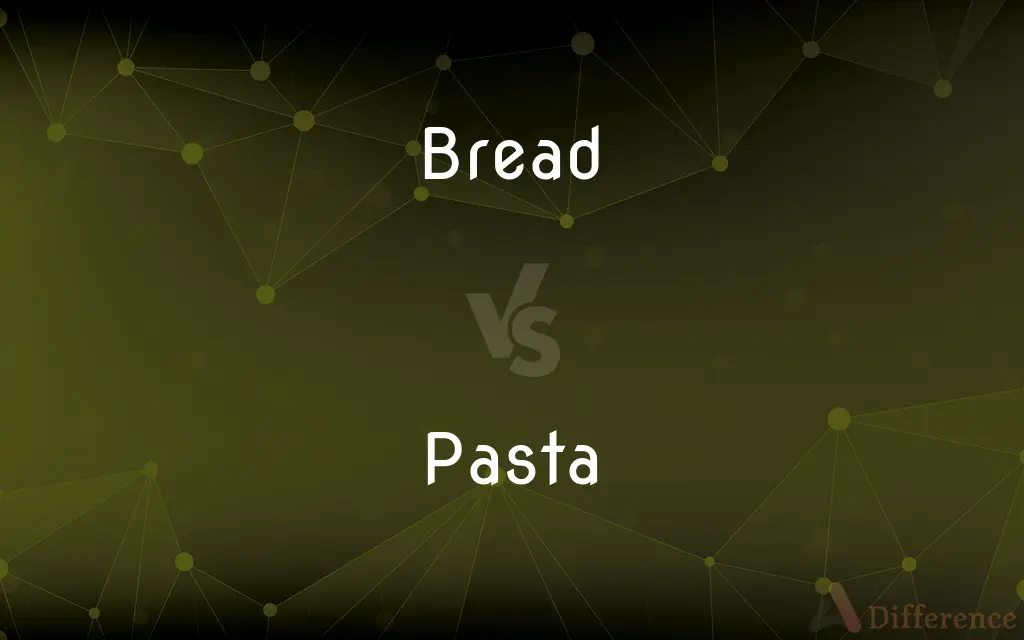Bread vs. Pasta — What's the Difference?
Edited by Tayyaba Rehman — By Maham Liaqat — Updated on April 9, 2024
Bread is a staple food made from flour and water, often leavened and baked, while pasta is made from unleavened dough of wheat, water, and sometimes eggs, typically boiled.

Difference Between Bread and Pasta
Table of Contents
ADVERTISEMENT
Key Differences
Bread is prepared by baking a dough made from flour, water, and usually yeast, which allows it to rise. It comes in various forms, including loaves, rolls, and baguettes. Whereas, pasta is formed from an unleavened dough, made of wheat flour mixed with water or eggs, and then shaped into various forms before being cooked by boiling.
While bread is often consumed as a part of meals across the world, serving as a side or a base for other dishes like sandwiches, pasta is typically served as a primary dish, mixed with sauces, meats, vegetables, or cheese. The versatility of pasta in meals contrasts with the more supplemental role of bread.
The nutritional content of bread can vary widely depending on the type of flour used and any additional ingredients. Whole grain breads, for example, are rich in fiber and nutrients. On the other hand, pasta, especially when made from refined flour, can be high in carbohydrates and low in fiber, although whole grain pasta options offer more nutritional benefits.
Bread's texture and flavor can vary significantly, from the soft, sweet brioche to the hard, savory crust of a baguette. Pasta also offers a range of textures and flavors, influenced by its shape, the type of wheat used, and the cooking method, with options ranging from al dente spaghetti to soft, filled ravioli.
Bread has a longer history, tracing back thousands of years as a fundamental part of human diet across various cultures. Pasta, while also ancient, became prominent in Italian cuisine in the Middle Ages and has since become a global staple, highlighting the cultural roots and evolution of each.
ADVERTISEMENT
Comparison Chart
Base Ingredients
Flour, water, often yeast (leavened)
Wheat flour, water, sometimes eggs (unleavened)
Preparation
Baked
Boiled
Role in Meals
Supplemental, side or base for dishes
Primary dish, served with various toppings or sauces
Varieties
Loaves, rolls, baguettes, etc.
Spaghetti, penne, ravioli, etc.
Texture & Flavor
Varies (soft, sweet to hard, savory)
Also varies (from al dente to soft)
Nutritional Content
Can vary (higher in fiber if whole grain)
Often high in carbs, whole grain options available
Cultural Significance
Ancient, fundamental in many cultures
Prominent in Italian cuisine, global staple
Versatility
Used as side or base, less commonly as main dish
Highly versatile in meals, often the main dish
Compare with Definitions
Bread
Versatile in texture and taste.
Baguettes have a crispy crust and soft interior, perfect for pairing with cheese.
Pasta
Can be made from different types of wheat.
Durum wheat pasta is known for its firm texture and yellow color.
Bread
A staple food made by baking dough of flour and water.
Sourdough bread is known for its tangy flavor due to the fermentation process.
Pasta
A versatile base for a wide range of dishes.
Penne pasta is frequently used in pasta bakes due to its robust shape.
Bread
Often served as a side or used for sandwiches.
Whole grain bread is a healthier option for making sandwiches.
Pasta
An Italian staple made from unleavened dough.
Fresh pasta made with eggs is tender and pairs well with light sauces.
Bread
Can be made with various grains and flavors.
Rye bread is denser and darker than wheat bread, with a distinctive taste.
Pasta
Comes in numerous shapes and sizes.
Fusilli is great for holding onto sauce with its spiral shape.
Bread
Part of many cultural traditions and meals.
In many cultures, bread is a symbolic offering at religious and ceremonial events.
Pasta
Often served with sauce, meat, or vegetables.
Spaghetti Bolognese is a classic dish combining pasta with a hearty meat sauce.
Bread
Bread is a staple food prepared from a dough of flour and water, usually by baking. Throughout recorded history, it has been a prominent food in large parts of the world.
Pasta
Pasta (US: , UK: ; Italian pronunciation: [ˈpasta]) is a type of food typically made from an unleavened dough of wheat flour mixed with water or eggs, and formed into sheets or other shapes, then cooked by boiling or baking. Rice flour, or legumes such as beans or lentils, are sometimes used in place of wheat flour to yield a different taste and texture, or as a gluten-free alternative.
Bread
A staple food made from flour or meal mixed with other dry and liquid ingredients, usually combined with a leavening agent, and kneaded, shaped into loaves, and baked.
Pasta
A dish originally from Italy consisting of dough made from durum wheat and water, extruded or stamped into various shapes and typically cooked in boiling water.
Bread
Food in general, regarded as necessary for sustaining life
"If bread is the first necessity of life, recreation is a close second" (Edward Bellamy).
Pasta
Unleavened dough, made with wheat or other flour, water, and sometimes eggs, that is molded into any of a variety of shapes and boiled.
Bread
Something that nourishes; sustenance
"My bread shall be the anguish of my mind" (Edmund Spenser).
Pasta
A prepared dish containing pasta as its main ingredient.
Bread
Means of support; livelihood
Earn one's bread.
Pasta
(uncountable) Dough made from wheat and water and sometimes mixed with egg and formed into various shapes; often sold in dried form and typically boiled for eating.
Bread
(Slang) Money.
Pasta
(uncountable) A dish or serving of pasta.
Bread
To coat with bread crumbs, as before cooking
Breaded the fish fillets.
Pasta
(countable) A type of pasta.
Bread
(uncountable)
Pasta
Any of a variety of edible unleavened doughey preparations made from flour, eggs and water, originating in Italy, and shaped into various forms, such as solid strings (as spaghetti), hollow tubes, or layered squares (ravioli). They may be mixed with various sauces, often having a tomato base, or filled with meat or cheese fillings.
Bread
A foodstuff made by baking dough made from cereals.
We made sandwiches with the bread we bought from the bakery.
Any leftover bread can be put into the pudding.
Pasta
Shaped and dried dough made from flour and water and sometimes egg
Bread
Food; sustenance; support of life, in general.
Bread
(countable) Any variety of bread.
Bread
Money.
Bread
Breadth.
Bread
A piece of embroidery; a braid.
Bread
(transitive) To coat with breadcrumbs.
Breaded fish
Bread
To make broad; spread.
Bread
(transitive) To form in meshes; net.
Bread
To spread.
Bread
To cover with bread crumbs, preparatory to cooking; as, breaded cutlets.
Bread
An article of food made from flour or meal by moistening, kneading, and baking.
Bread
Food; sustenance; support of life, in general.
Give us this day our daily bread.
Bread
Food made from dough of flour or meal and usually raised with yeast or baking powder and then baked
Bread
Informal terms for money
Bread
Cover with bread crumbs;
Bread the pork chops before frying them
Common Curiosities
What is the main difference between bread and pasta?
Bread is typically leavened and baked, making it light and airy, while pasta is unleavened and boiled, often resulting in a denser texture.
Are there gluten-free options for bread and pasta?
Yes, there are gluten-free options available for both bread and pasta, using alternative flours like rice or almond flour.
How are bread and pasta served in meals?
Bread is commonly served as a side or used for sandwiches, whereas pasta is usually the base of a dish, mixed with other ingredients like sauces and vegetables.
Can bread and pasta be part of a healthy diet?
Yes, both can be part of a healthy diet, especially when choosing whole grain options and paying attention to portion sizes.
What are some common types of bread and pasta?
Common types of bread include sourdough, whole wheat, and rye, while pasta varieties include spaghetti, fusilli, and ravioli.
Can bread or pasta be made at home?
Both bread and pasta can be made at home, offering opportunities for customization in terms of ingredients and shapes.
Is pasta always made with wheat flour?
While traditional pasta is made with wheat, there are varieties made from other grains and legumes for nutritional diversity or dietary needs.
How do the nutritional values of bread and pasta compare?
Both can be high in carbohydrates, but their nutritional value varies with ingredients; whole grain versions provide more fiber and nutrients.
What is the role of eggs in pasta?
Eggs can be added to pasta dough to enrich its flavor, color, and texture, making it tender and slightly richer.
How does the preparation of bread and pasta differ?
The key difference lies in their preparation: bread is leavened and baked, giving it a distinct texture and crust, while pasta is typically boiled, resulting in a softer, yet firm texture suitable for combining with sauces.
Share Your Discovery

Previous Comparison
Feudalism vs. Communism
Next Comparison
Repair vs. MendAuthor Spotlight
Written by
Maham LiaqatEdited by
Tayyaba RehmanTayyaba Rehman is a distinguished writer, currently serving as a primary contributor to askdifference.com. As a researcher in semantics and etymology, Tayyaba's passion for the complexity of languages and their distinctions has found a perfect home on the platform. Tayyaba delves into the intricacies of language, distinguishing between commonly confused words and phrases, thereby providing clarity for readers worldwide.












































